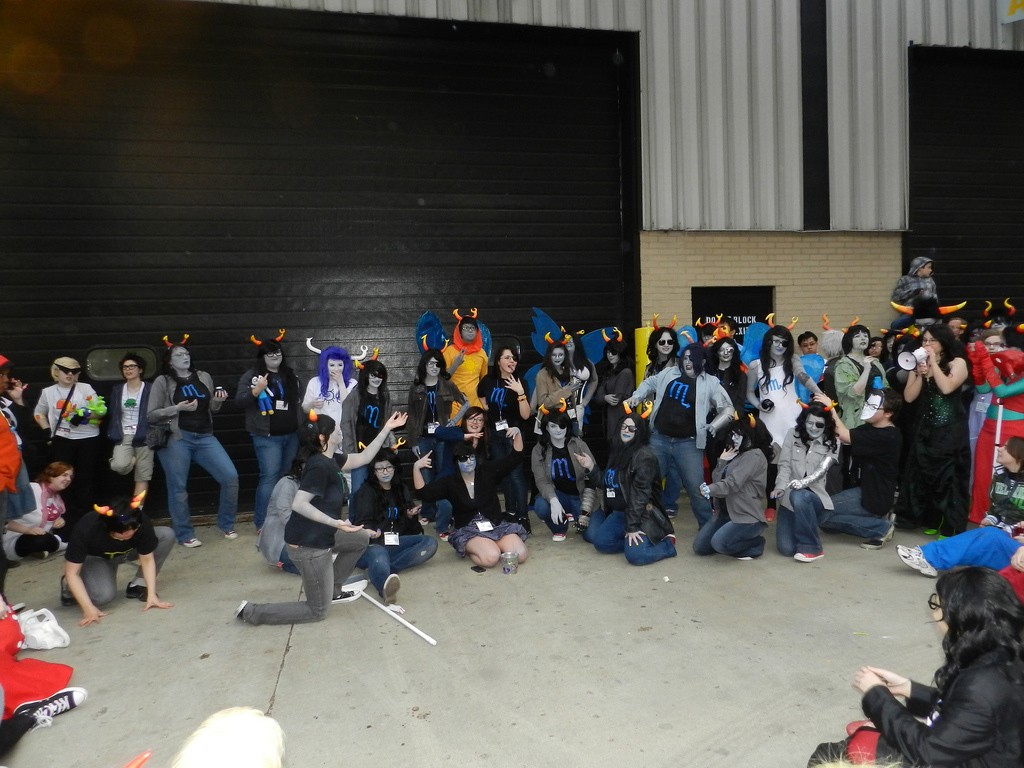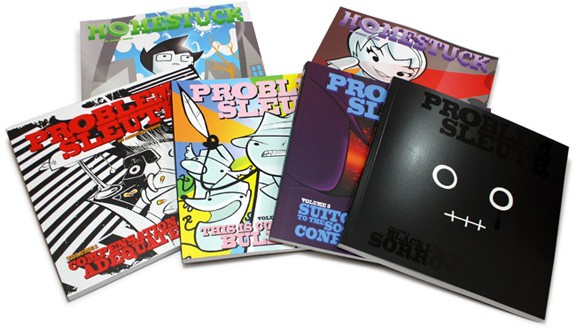‘Scott Pilgrim’ Guy Interviews ‘Homestuck’ Guy: Bryan Lee O’Malley On Andrew Hussie
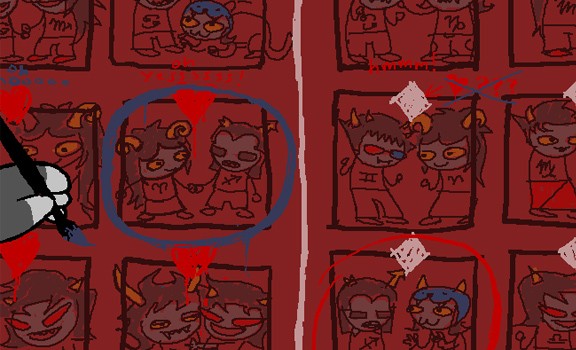
MS Paint Adventures began as a weird webcomic where reader suggestions dictated the action every day, leading to predictably silly ends. Creator Andrew Hussie ran several stories there in the guise of old pictorial text adventure games (think King’s Quest, if your memory goes back that far). In April 2009, three days after concluding the epic detective story/game Problem Sleuth, he jumped right into his current project: Homestuck. That’s when everything started to change.
Homestuck is about four 13-year-old internet friends trying to play a computer game that will either save or destroy the world. It is sprawling and complex, dumb and hilarious, and full of the most fiendishly intricate references to the basest turds of pop culture. It’s about the internet — cliques and fandoms, the good stuff and the icky stuff. In Hussie’s own words, Homestuck is “made of pure internet”.
Oh, and it has easily a million daily readers, raised nearly $2 million on Kickstarter, and is actually really good. I have some experience with weirdly popular youth-oriented videogame-referencing epics (i.e. I created the Scott Pilgrim series), so after plowing through Homestuck (twice!) I set out to ask Andrew Hussie some of the burning questions on my mind.
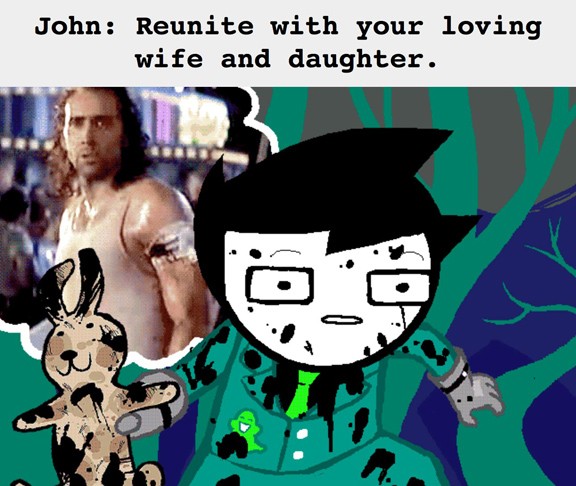
If you’ve been to a comic convention lately and seen a giant group of teenagers giggling about something you don’t understand, they were almost certainly Homestuck fans. Right now Hussie’s running a Kickstarter campaign to produce a professional Homestuck-derived computer game and as of this writing it’s raised $2 MILLION DOLLARS. This whole phenomenon was so interesting to me that, a little over a year ago, I delved into the seemingly-impenetrable story itself, starting with page one… all the way to page five-thousand.
Yes, Homestuck is long, and it keeps getting longer (it’s currently ongoing, although Hussie promises the end is in sight). It’s verbose. It’s mysterious. While we could quibble all day about whether it is or isn’t a comic, here’s what it is: pictures and words. There’s no speech balloons. Each “page” is generally one panel. Sometimes there’s text — often thousands of words presented as a chat log between two or more characters. Sometimes there’s just artwork, wordless action, for many pages in a row. Some pages are animated .gifs. Some pages are a full-blown 15-minute, lavishly-animated cartoon features. Some pages take the form of an honest-to-god playable video game.
The most important thing about Homestuck is, in this reader’s opinion, that it’s excellent. It’s a massive undertaking of deftly-handled long-term serialized storytelling. It’s well-written and thoughtful. It has things to say. It takes weeks and weeks to read the whole thing (to date), and it certainly isn’t for everyone, but it’s as much worth your time as any comic I can think of. What is the deal with Homestuck and Andrew Hussie? Read on to find out.
BRYAN LEE O’MALLEY: The general premise of MSPA was, initially, making fun of the dumb silliness of text parser adventure games. But those largely stopped being made in, like, 1989. So for me, the big cognitive dissonance at first was: here’s a story presented in a text parser format attracting a massive audience of teens. Most of these kids literally could not have been born in the era when text parser games were even a thing at all. So… what are your readers taking from this? Are they just investing themselves in the meat of the story and kind of glossing over the presentational/meta stuff? Do you think they even know or care that the text parser is an archaic gaming interface — is it now just a “Homestuck thing” to the younger readers?
ANDREW HUSSIE: The commands and mock-text parser stuff were concepts in much better alignment with the story and website in early Homestuck and in the stories before it, when the readers would submit those commands and I would pick one and draw the response — where I was literally functioning as the text parser myself. As Homestuck went on, and the user submission system was retired (quite necessarily, about a year into it), the text command system has become a little more esoteric. A lot of the commands started getting a little lofty or abstract, or tied to no character in particular (like “Descend.”), or just a blank “==>” when all we really need to do sometimes is turn the damn page. It’s funny how the invisible action of turning the page is something that requires no consideration from the author of a typical book, but it always needs some thought in this case. In a way these commands really do start becoming “just a quirky Homestuck thing,” even if that’s all they ever were in the minds of very young readers. A lot of the time the commands to me seem to serve as a simple title for a page.
Before Homestuck, I think the site really did tend to attract more people in [their 30s] or a bit younger, due to a much more clearly telegraphed parody of text adventure games and those people would dig it for that reason — the nostalgia and novelty surrounding that particular storytelling mechanism. But Homestuck added a lot more elements, more engaging story and characters, very much in the vein of young adult content, and as such has attracted many very young readers. For most of them, I do think the text adventure elements were either lost on them or were just something that had no appeal other than something that is an acquired taste — things they eventually learned must be embraced as part of the overall “Homestuck experience.” But at the onset, that archaic gaming parody stuff, and the slow, peculiar pacing it entails, tends to just be one of the many, many barriers to overcome in engaging with this and learning how to enjoy it. I couldn’t even count how many times I’ve read something like “OK I’ve tried to read this thing like five times and just never really got it. But the sixth time, oh man, I finally pushed through the early stuff somehow and now I am A Homestuck.” And then all successive posts on their tumblr seem to be nothing but photos of themselves wearing horns or something.
So in response to the general question you asked, how I feel about that, it’s a combination of being highly amusing and quite amazing. Once that conversion happens, it often seems to be absolute. Like the things that were once impediments to becoming invested in the story seem to now be fully embraced, and even celebrated whenever those elements resurface. Maybe it’s that the harder you have to work to figure something out, and the more concentration you have to apply, the more devoted you become once it all finally clicks and you get it.
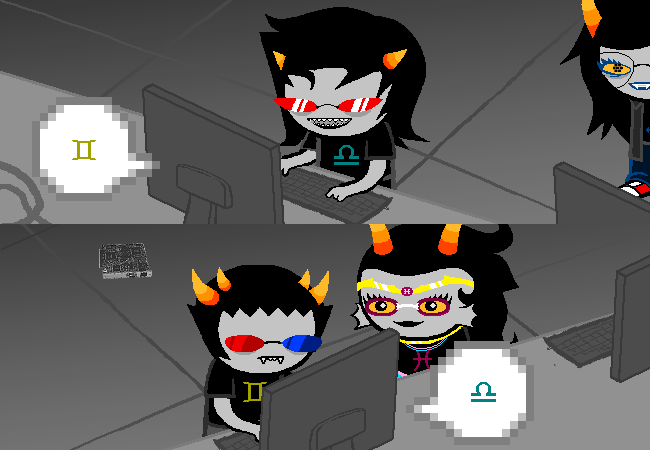
O’MALLEY: I guess the next topic that grabs me is “Internet Friends.” The four main characters in Homestuck have the most relatable internet friendships I’ve ever seen in fiction. It’s a new kind of relationship that you capture really accurately. The characters are best friends, but they haven’t technically met, and they only ever interact through this chat medium. And this is all presented via communication interfaces that feel much more 1999 than 2009. I mean, “Trollian” the chat client is I assume a riff on Trillian, and Pesterchum feels more like ICQ than anything. It brings me rushing right back to my earliest days online.
What was it like to start writing these characters in 2009, and how much of the early chat logs grew out of your own online relationships?
HUSSIE: The instant messaging style definitely draws from 1999 more than 2009. AIM and ICQ rather than Skype and whatnot. This too is a bit of a technological throwback, like so much of the gaming satire. But that said, even though the apps are all different and conventions have morphed, there isn’t that much that’s changed about talking to friends on a computer via text. It’s a type of interaction which has given rise to some totally distinct kinds of social relationships, blossoming out of nowhere in the late ’90s, early 2000s, and they have actually become the defining types of relationships for so many young people today. It’s almost unbelievable to consider how many young people there are now who consider their best friends to be people online, who they’ve never met.
That is I’m sure a major feature of the story that has resonated with many readers, that it reflects those types of relationships somewhat accurately. It’s a quirky kind of friendship, ones built mostly on text exchanges. Those relationships, especially for those who don’t feel very socially dynamic in real life, can develop more quickly and can often feel stronger than real life ones. Maybe because it’s easier to find people you connect with better from the internet pool, or that conversing this way diminishes some of the social barriers that real life interaction involves. Whatever it is, it tends to create some pretty strong bonds, and that’s become standard these days. But the other defining feature of those relationships is, unless you live somewhat nearby, obviously you never get to actually be around that person. So these friendships, while strong, can also be primarily characterized by an inevitable sense of long term separation and alienation. The fact that meeting is not practical or sometimes impossible, especially with the very strong friendships, kind of turns into the elephant in the room for that relationship. When will they get to meet, or will they ever, can become the operative question and a source of frustration.
I’m sure that element in these relationships has led to the various themes of alienation found throughout Homestuck, contributing to some of the more melancholy material. Meetings between the kids do not happen for quite a long time, and it’s fairly significant and usually feels special when they do. There are a bunch of frustrating near-misses. All that stuff just keeps reminding people what it’s like to have such relationships. The domestic situations of the kids are also very isolated and kind of empty. When they get in the game, they continue being isolated on their own planets and keep corresponding through the internet. You find themes of alienation wherever you look and it all points to what it feels like having your most important relationships conducted through the internet.
The trolls are a larger group and their dynamic is a little more “modern internet” than the kids, I think. In the early days of the internet it was more common for internet relationships to be only like those between the kids, but that was before the Facebook explosion and all that, which completely tangled real life socialization with the internet as the cultural norm. So you have some trolls who are friends with trolls who live far away and they’ve never met, but also some who are neighbors or live nearby, but they still all communicate with each other on the net as one big group of friends. It’s a much more contemporary sort of internet clique. It is also maybe a little more realistic, with respect to the size and age of the group, in that it generates much more drama and emotional theatrics.
I have experience with internet friendships from back when they were a little more new to society, like late ’90s to early 2000s. When I was 13, obviously all this was pure science fiction. I somewhat draw from my experience with how these types of online relationships and social interactions universally work, but also it comes from observation of how others engage with each other online, those younger than me or in different situations than I ever was. Mainly my experience guides the rhythm and feel for this sort of repartee, the jokey, rambling, casual quality to it all. And that style became responsible for the genetic makeup of how the entire story was built, how the vast majority of the story’s text reads, how characters are shaped and info is revealed and the plot is advanced. It’s one of the things that make the story a winding road. It’s an outcome that’s self-evidently encoded in the premise when you say, “Time to make a story where character interactions are driven exclusively by rambling, true to life chat logs.”
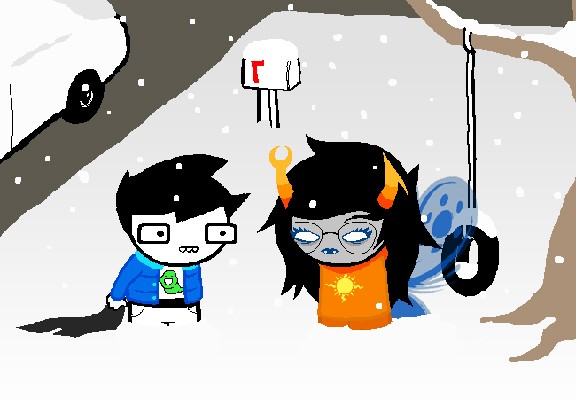
O’MALLEY: As the story evolves, do you start feeling hamstrung by the use of chat logs? To me it adds a weird poignancy that later, even when they’re standing in front of each other, they kind of have to use the internet to communicate.
HUSSIE: I don’t think I have ever said, “AUGH why can’t I just make a damn speech bubble??” The characters always spend so much time apart that it’s natural to just keep them talking on computers. Times where they’re not, it gives me interesting chances to play with the rules a bit, or devise new dialogue mechanisms that grow out of the old ones. Like, one rule is they can always talk directly to a sprite because they’re just game constructs, like guides. But sometimes characters prototype themselves and become sprites. So you have those few cases where characters directly talk to each other. Then you have dream bubble mechanics, which kind of cheat. They tend to start out as memories, like flashbacks, of characters talking online. But then when they remember, and start walking around the dream and stand face to face with others, they just keep talking out loud, using the same pesterlog convention as if they’re still typing. They even continue using their typing syntax and emoticons and stuff when they speak out loud.
Also waaay down the road I finally did invent a true mechanism for face-to-face dialog. Called “dialoglogs.” But they can only be earned after achieving a very high level, becoming a god, and even then progressing a little higher than that to unlock the achievement of simple dialogue without a chat client. This is itself a gag.
O’MALLEY: How did you come to this format? What prompted you to do a story about internet friends told in this internetty multimedia format? It looks simple and elegant from here, but was it stumbled on or was it hard-won?
HUSSIE: It was a major, long term case of one thing leading to another, all very organically. Homestuck was just: Problem Sleuth plus a little more of a story, try adding a dialog system, try adding Flash animation, see what happens. There was also the different premise; where Problem Sleuth was “detectives in offices,” Homestuck was “kids in houses.” When people asked me what I was doing next, that’s how I would put it: “Something with kids in houses.”
A lot of things about it were preconceived, like the four kids and what they’d basically be like, some game rules, house building stuff, creation myth stuff. But just as much if not more arose through the process, like the trolls, carapace people and dream selves and god tiers, points of execution like huge flash movies which I never thought I’d do, playable games… the list is endless.
So yeah, a story about kids on the internet, that is told in a way that is like, made of pure internet, is something arrived at pretty organically and not something I can say I envisioned before starting all at once. Making something that really feels like it belongs on the internet, something that seems to actually understand it exists on the internet, involves doing quite a lot of things. The media exploration is part of it, but also the self aware elements I think, where the connection between the reader/fandom and the story is always alive and palpable.
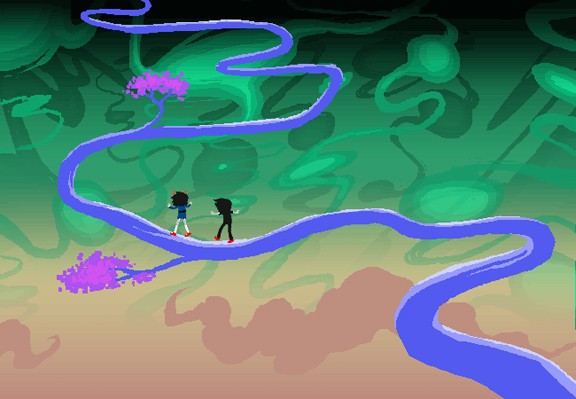
O’MALLEY: To recap, Problem Sleuth was about a detective stuck in his office. Homestuck starts with a kid stuck in his house. And for the first couple hundred pages that’s all it seems to be — but then it grows and grows. There’s a whole world in there. It gets big and weird and intense. Reading it a second time, I start to see the seams of where stuff was probably made up as you were going along, but on a first read through, the big reveals not only blew me away but seemed to have been in place from the first page. I think this mostly means you’re a great writer of serial fiction and you think well on your feet.
HUSSIE: Thanks for saying so! Dexterity is possibly part of the answer, but the whole subject of “what was planned when” is very tricky. Do all authors have every single idea totally hammered out before they begin writing a novel? Of course not. Some things like keystone ideas are planned well in advance of the first page. Others emerge organically from the process. Anything that is introduced spontaneously can be smoothed out and heavily disguised with the luxury of an editing phase, but this here is essentially glass box storytelling. You’re seeing how it’s being made as I go, and every single decision is committed to absolutely once it’s on the site, with no retconning ever. Nothing is ever written or drawn in advance; there’s no “buffer,” only a mental outline of ideas and key plot points to cover which is all executed little by little. So when people look into the glass box and the next thing that comes out makes them say “holy s***, was that planned?” the answer is almost always, “that’s a complicated subject.”
When did the idea need to take shape for it to be considered planned development? A month in advance? A year? How exactly do we profile the genesis of an idea? Do we draw a tight circle around a particular “eureka moment?” Or is it sometimes a much wider circumference? Could you circle an entire year, and say, “There. That’s when I had the idea.” Sometimes I find myself likening the birth of an idea or a vision to a slow gathering of storm clouds. They accumulate, they brood in the distance, always getting closer. It’s ominous, something you can’t escape from rather than something you’re actively trying to precipitate. Then it’s finally there, and you have no choice. You have to do it. That cloud accumulation often is the planning process. And it happens while you’re building a story just as often as before you begin. Maybe more often. Sometimes those little clues at the beginning, or repeated themes that mount throughout which all scream foreshadowing for certain payoffs, those were actually artifacts of the accumulation which lead to the full realization of the idea. It’s not really just “retroactive foreshadowing” either, though that can also be a device in play. It’s more like listening carefully to the marble of the story and determining how it wants to be carved, when I was also the one who created the raw slab of marble in the first place.
Less abstractly, there were definitely a lot of things nailed down before page one. The concept of the game as a creation myth, a lot of the game rules, stuff like that. So even though there’s plenty of thinking on my feet, and allowing other major elements coalesce as I go, there were still always some huge plot beacons I was always marching toward in some way with every page. The fact that there’s clear order driving the most major revelations at the heart of the story probably strengthens the illusion that every other bit of it is just as maniacally calculated as well. Working on something like this borrows somewhat from the art of being an improv comic. You probably go into the act with some major, high level guidelines for the performance no matter what people want you to do, but also have a lot of room and dexterity to adjust to the specifics, and it’s a whole discipline unto itself knowing how to make those adjustments in a way that seems natural or even planned and rehearsed.
O’MALLEY: I identify strongly with your “gathering storm clouds” metaphor for ideas coalescing. That’s a very evocative way of putting it.
I was going to ask how much time elapsed between the end of Problem Sleuth and beginning of Homestuck, but I just checked the logs and it was under a week, which is nuts. Were you just brimming with ideas for the new story during the last weeks/months of Problem Sleuth? I know I’m constantly coming up with big plans for the next story when I should be finishing the current story.
HUSSIE: I began Homestuck on 4/13, but I began the Homestuck Beta on 4/10. That was three days after Problem Sleuth ended. A huge part of the MSPA exercise has been to just throw myself into it no matter what, whether I’m “ready” or not, and then just never stop. The challenge is always to take whatever idea I have for what’s next, do it now, and somehow make it work, even if it’s kind of stupid or just totally nuts.
Even though there was almost a nonexistent gap between Problem Sleuth and Homestuck, there was still definitely a planning phase for Homestuck going on at the tail end of Problem Sleuth. It was much more like that slow accumulation of storm clouds I described earlier. It all kind of coalesced very ominously over the final months of Problem Sleuth, then it was over, and it wasn’t really a matter of hopping over to the next fun story casually. It was more a matter of having no choice, and then beginning the climb on a new monstrous project that was undoubtedly going to take over my life and that of many others in ways I couldn’t quite imagine, but still basically understood on some level.
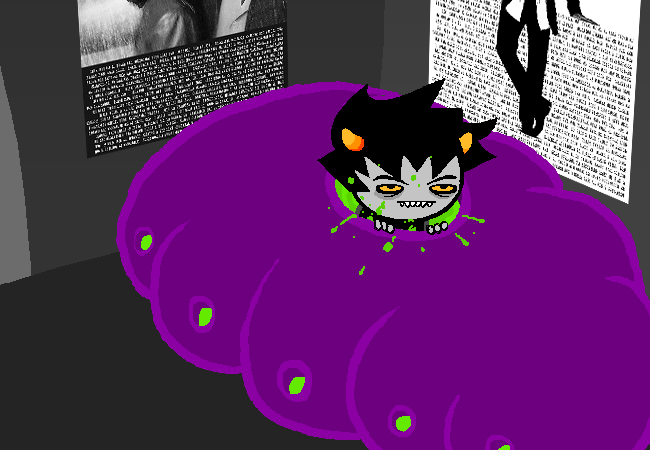
O’MALLEY: What about pacing? It always feels very deliberate throughout. I think on multiple occasions you tease us with fragments of a character literally hundreds of pages before fully revealing them. The buildup always feels very measured. Are you buying time to make new stuff up? Or do you have stuff made up and just take your time spooling it out?
HUSSIE: I try to put myself in the shoes of readers a lot when making it, especially ones who approach it [via the archives]. Probably because the majority of people who will ever read it will read it that way (including most current readers, who have had to catch up through five acts before following along.) So when I make decisions on how to pace certain things, when to show payoffs and big reveals, what points to foreshadow and how heavily, I usually do all that with an eye toward the experience of someone reading “archivally.” I think the whole thing gels together better when read that way. Novelty of everything stays fresher throughout, certain plot points and details stay afloat in your mind better, all that helps catalyze a quality impact for the more striking sequences and surprising reveals when they do happen. It sounds like these factors may have benefited your experience, which is always nice to hear.
I honestly think this is one reason why it’s exploded. Large amounts of people are finally catching up with the whole thing I pictured it would be, receiving all the crazy s*** as one massive shot of adrenaline, confusion and media titillation, and responding well to it.
I still throw plenty of bones to serial readers, though. On a day-to-day basis, even if we aren’t blasting off to plot resolutions as quickly as serial readers will often demand, there’s always something funny or entertaining going on, like gags, fun character interactions, various shoutouts to things emerging from the fandom which then become woven into the fabric of Homestuck lore, and so on. Advancement is always present in subtle ways, sometimes concealed inside blocks of casual banter, or lurking passively in a visual. We learn a little tidbit here, find another little clue there. It all adds up and keeps it slowly ticking everything forward. When read archivally, it all adds up faster.
The bottom line on pacing I think is: I am very patient. Possibly even to a fault. But if you seek to tell stories that involve intrigue, particularly which involve highly combustible payoffs, I think it’s better to err on the side of patience. There is always a right time to reveal something.
O’MALLEY: This seems like a good segue into process. I want to start with the basics: What is your day like? What is your week like?
HUSSIE: I think in the last year or so it’s fair to say I’ve kiiiiiind of eased up on the nonstop grind. But I’ll rewind the clock to, say, 2010, when I was definitely in the full throes of Homestuck’s silly climb. There just isn’t an answer to the question that isn’t “literally every waking hour” creating this thing. The day was like this: I’d wake up. Read some emails, see what people are saying about the story here and there, then just get to work. This most often involved writing first, either a pesterlog or the little sub-panel blurbs. I’d stack up the writing for all the panels I wanted to make for that batch, then I’d draw them or mess around with an existing art file to quick-and-dirty something out.
The faster the panels were made, the more I’d post in a day. If panels were coming quick, that could have been a 10-20-page day. If the panels were simple, but very text-heavy, then fewer. But the shortcuts and time saved were always immediately reinvested into further work on the story. Like, a lot of days there would be update batches, like the early evening batch, then I’d eat or something, then work on the late night batch and post all those at 4am or something. The bottom line is there were never daily quotas or milestones or anything like a schedule. It was just: get as much done as quickly as possible, post it, then almost immediately begin working on more.
Which sounds ludicrous, but that regimen was always inseparable from the product in my mind. It also helped that for the most part, any given slew of panels is relatively easy for me, embodies a bunch of entertaining ideas I’d been wanting to bring to light often for some time already, and serves as an esoteric form of personal entertainment when you factor in the dialog between the work and readers which the instant output precipitates. The only type of work I’d ever call “hard” was Flash work, and often that’s putting it really lightly. Those were usually days, or a week, of not posting anything while working twice as hard as usual, a lot of times actually sacrificing sleep which I never tend to do otherwise, just to get the f***in’ things done. This isn’t recommended. Actually, none of this is recommended.
O’MALLEY: OK, so you have a work ethic that borders on (or brazenly charges into) crazytown. What portion of your day/week/month breaks down into note-making, writing, drawing, revising?
HUSSIE: I’d break it down like this on average: 0%, 49.5%, 49.5%, 1%. Notes are almost nonexistent. I have a few scattered one-word blips or phrases about this or that in my file, but that’s it. One of the things about doing this constantly, like a full mind-body-life thing, is it just seems to keep everything about the story “alive” in my head all the time. I think if I did things like take breaks or have a more sparse schedule, it would kind of fall apart in my head and I’d have to resort to documents and flow charts and stuff, or more realistically, just get fed up and quit. Revising is also very light. The thing is supposed to be very light on editing and revision, while always charging ahead.
O’MALLEY: So would you say the dialog is basically stream-of-consciousness from story beat to story beat?
HUSSIE: It was always fairly stream of consciousness, which initially resulted from embracing chatlog style repartee. It’s actually very useful from a “just get something on the page and go from there” standpoint. There is a bit of refinement sometimes, deleting some blocks, adding a line here and there. Usually it’s pretty close to prime-time-ready from start to finish. Some dialogs are more taxing and require serious thought if they’re more plot critical, revealing stuff in just the right way, or involve gymnastics with internally consistent timeline bulls***. Sometimes I have to go back and add troll quirks, which can be terrible [note: the troll characters all speak/type in distinctive hacker-style lingo]. For some characters I really quickly took to using a fan-made troll text conversion app.
O’MALLEY: How far out do you work? Are you on the razor’s edge here? Do you compose the day’s pages that very day and post them?
HUSSIE: Yep, it’s make pages, put ’em up. If there were ink involved, the ink would literally not be dry on like 95% of all pages the moment they went up. But there is also a living outline in my head for what to do with the story for the next month’s worth of updates or so. It’s often subject to change though. And almost invariably, the events I picture take more time to execute than I envision. Like often a week or more longer, but sometimes it takes months longer to get to some particular thing I was picturing.
O’MALLEY: You’ve said there are over a million Homestuck readers. I’ll just scratch the surface by asking: when did you realize it was getting crazy? And when did it go from being crazy online to burgeoning into a real-world thing?
HUSSIE: The moment it went crazy was really unmistakable and totally obvious even at the time. It was when I brought the trolls into the picture. Really, not even that long into it, either. Hivebent, the sub-act introducing them, was about 600 pages long, and took a full summer to make. I think the existing fandom began turning itself into an insane cyclone about halfway through and started sucking more people into it. It was an extremely wild and contagious phenomenon, fueled largely by fan art completely infesting places like Tumblr and 4chan, and cosplayers starting to get a little feistier and more widespread. The site always felt “pretty popular” to me, at least by my own standards, since the end of Problem Sleuth. But that was the first time where the element of true hysteria began to creep in for me.
Other than that, there was one other critical spike in my perception of the hysteria, which I think was Otakon last summer. Before that, I’d see a lot of photos of cosplayers here and there, but they were never in groups bigger than 10 or 20. Photos coming out of that con had groups of several hundred Homestuck cosplayers. And groups of that size have been the trend in anime cons ever since. It was some weird critical mass of cosplay that took place at that con and it never looked back. The Homestuck cosplayers at anime cons seem to routinely outnumber all the other types of cosplay combined, and as the people who don’t like it often lament, Homestuck isn’t even an anime.
The photos that surfaced from Otakon had a mildly spooky feeling, and I don’t think it was for just me. They were kind of passing around Twitter, here and there, and it felt like people not following the thing closely were caught off guard by it. Like, looking at something that doesn’t register as a rational, understandable thing. Like, “uh… what is… hmm. What? Did those 50 kids in the blue hoodies really all dress up as the same character?” Really, my sense is that Homestuck as a phenomenon seems to make some people legitimately nervous. I guess because it really just doesn’t seem to make any sense. Especially to those who don’t know anything about the story, try to understand it, go to the first page of the site, and say “WHAT?”
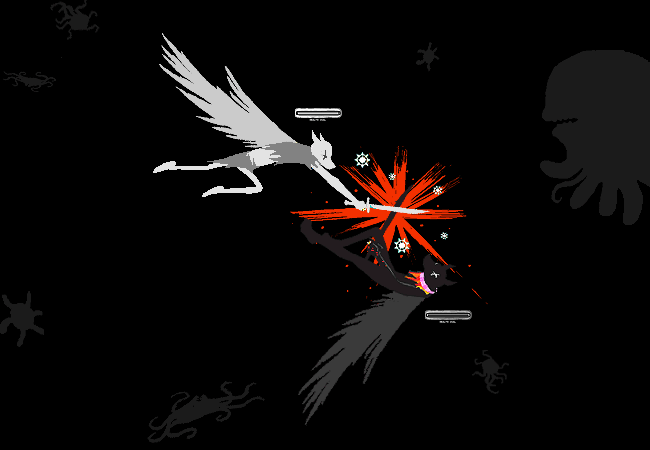
O’MALLEY: You obviously have been working on Homestuck nonstop for, like, a pretty long time now. How do you make your money? When did you start making enough to get by? For me there was a pretty specific window of time where it switched over from being “this is sh***y” to “this is OK now,” but it was to do with books and royalties and suddenly having enough books in print (four Scott Pilgrims) for the math to finally be in my favor. I don’t know what the equivalent is for a Web Person, so I wonder.
HUSSIE: I’ve been entirely supported by MSPA since, I guess, the latter half of Problem Sleuth, though things were still pretty lean back then and stayed that way for the first year or two of Homestuck. I don’t think it ever crossed my mind to think “this is sh***y” because I was totally used to living that way forever, and I thought it was totally cool being able to make “free money” with internet ads, which stayed as the biggest source of revenue for a good while (it’s now easily the smallest, though). But there was definitely a moment where it crossed the line and became “this is definitely far from sh***y” and that was also the critical fan spike I mentioned earlier, introducing the trolls. I was still underestimating the profitability brewing under the surface, though. I had the idea to make the zodiac shirts but thought it would be a pretty niche item and didn’t want to bug my usual shirt maker Topatoco with 12 new designs. So I got my own company, What Pumpkin, to make a bunch, but woefully under ordered. We had a huge amount of trouble keeping those shirts in stock and shipping out all the orders for like a solid year after that. That’s pretty much been the story of all merch since then; constantly underestimating steadily growing demand. It was that way with the early runs of the god tier stuff too.
I seem to have this knack for falling totally ass backwards into highly marketable ideas, like the troll zodiac symbols. It really seems like such a money making scam when you look at it. Like, taking these icons that have been around forever, give them all one color which is easy and cheap to print on a simple black shirt, associate them with some distinctive characters, and also the zodiac which people can intrinsically identify with (having a “patron troll”) then just slap it on a bunch of merch and rake in the dough. The god tier stuff also felt that way, 12 nice colorful icons, also associated with particular characters, special powers etc., and canonically associated with a particular garment, a hoodie (i.e. godhood), so any cynical observer looks at it and can say, “Heh, look what bulls*** Hussie cooked up to sell hoodies.” But honestly this is always accidental. The ideas always just seemed cool to me, filling out the zodiac with troll characters, fleshing out the full god tier system and such. I’ve never actually put anything in the story to sell anything. But throughout the entire ride, every time I turn around, I’m saying, “Oh, whoops. Guess I gotta sell that now.”
When I started selling books, that also really kicked up the revenue. And like you said, it starts stacking up with more books out. I have five out now and that’s really adding up, and I’m barely even scratching the surface of publishable content. Homestuck could have 10 books alone, probably more. This is another one of those “completely accidental moves of merchandising genius” on my part. Making a type of story that is produced so quickly, that I can put out in a few years the same number of books that might take someone else a decade to stockpile. I very rarely have a palpable sense of how much work I’ve actually done over the last few years until I’m sizing up the book project. Then, once the magnitude of the bookmaking job begins to sink in, I start muttering, “Oh my god, what have I done…”
O’MALLEY: The blogosphere seems to ignore Homestuck. There hasn’t really been any intermediary discussion. I wanted to read a big interview with you, but there wasn’t one, so I had to do it myself.
HUSSIE: I always understood the blogs neglecting Homestuck, because I’m pretty well able to step outside of it and try to honestly see what it looks like to random people. And what I see is something that couldn’t possibly be less penetrable to casual understanding. I think weighing the massive cult phenomenon that’s apparent in public, against what the first page of the story looks like… that kind of says it all. It just so perfectly “does not compute,” looking at this dinky piece of s*** aliased drawing of a kid with a cake versus an army of screaming teens in gray makeup. How do regular people even process that? And the scary thing is, even figuring out how to reconcile that disparity is barely even the beginning of “understanding it,” so I can completely understand people giving up before even trying. In fact, I’d probably do the same.
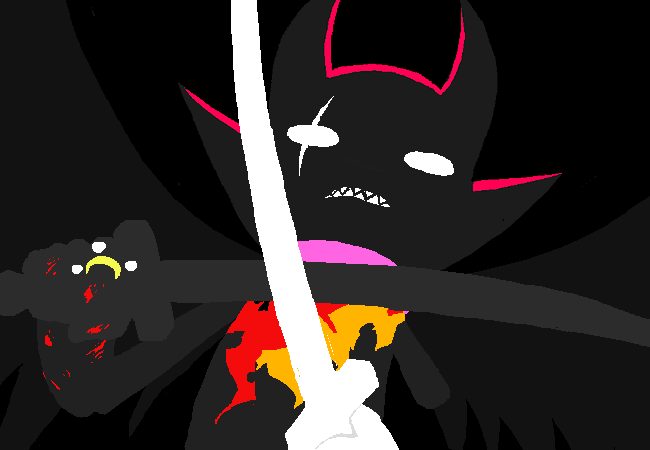
O’MALLEY: The other side of the coin is the active haters. In fact, seeing kids hating on Homestuck and Scott Pilgrim in the same breath was one of the things that first made me decide to hunker down and read all five thousand pages of it. What are your thoughts on hate?
HUSSIE: Homestuck kind of took a while to accumulate honest-to-god haters. It’s probably for the exact same reason there aren’t a lot of true “mehs” out there. It seems that most of the haters have entered the hatedom through their antipathy toward the fans. People’s irritation and loathing for the fandom’s antics always seems to exacerbate any slight dislike of the story they have, and is really often a catalyst that transmutes “meh” into full blown hate, for all things Homestuck no matter how irrational or petty. Like… these idiots are wearing gray makeup, I’m so pissed, let me just load up MSPA so I can confirm and then rave about how bad this thing is. Oh god I was right ALL THESE JOKES SUCK!
I think those bother me a lot less because they’re so patently irrational. The ones that are more frustrating tend to be the kind of haters who once seemed like they were into it at some point, but one thing or another soured them on it and now all of a sudden the whole thing is crap, as if they previously were an unreliable witness of content. I guess this is really something at the heart of haterism that is almost unavoidable for any work. It takes time to deliver anything, and for it to blossom into whatever it’s going to become and to reveal its true statements. That almost always takes years, so it’s a natural race against people’s attention spans, or even just the inscrutably shifting terrain of their preferences. There are always going to be things that people will want a story to become, and those preferences always vary, so the story is always gonna cross some people no matter what it does.
Where frustration as a creator comes into play is the factors that exist outside of the pure text are almost never acknowledged, like rate of delivery and shift of personal perspective. The hater always demands absolute acknowledgement of the text’s intrinsic flaws, and there are no factors whatsoever on the other side of the fence. As if a story is nothing but raw data to be deconstructed, and not actually a million different stories that come to life within a million different vehicles of consciousness.
Generally they don’t affect my work habits, but I guess earlier this year there was a period where I was feeling pretty dark about it. There seemed to be a critical spike in Homestuck hate then, I guess because the readership size finally cleared a certain threshold and some people just couldn’t take it anymore. But the feeling isn’t really characterized by increased doubt in what I’m doing, it’s more like a kind of depression that says, “Why bother working hard to make good work for idiots and a**holes???” But I guess that was a pretty small speed bump because that didn’t last too long. Everything always seems to be in the fast lane when it comes to MSPA, so I guess the funks might as well be too. Now if people rail on it, it barely registers as anything to me. Their bluster is the white noise of Wrong.
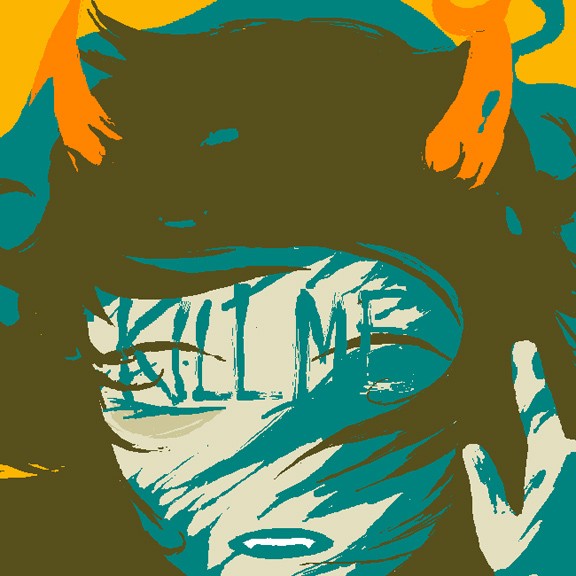
O’MALLEY: I want to talk about character romance and relationships, aka “shipping” — fans love this stuff. I wasn’t aware how much of a thing it had become until well into the Scott Pilgrim series, when I realized a ton of the fans had dismissed Ramona and were somehow fancifully giving Scott and Kim an ending together in their fan-brains. I started to play with that expectation in the second half of the series, at first playing with the theoretical idea of fanservice (like the swimsuit sequence and the girls-kissing stuff) and eventually realizing it was a real thing and having to steer the story back in the right direction (i.e. towards Ramona). I got a second chance to play with pairings when I wrote the videogame endings, which have Kim and Knives together, Scott with all the girls, Knives and Scott, etc.
When did shipping become a thing you acknowledged and began working with? You obviously shifted hard in that direction by the time of the hilarious and charming (and fully fan-functional) Troll Shipping Quadrants.
HUSSIE: I think it became obvious it was going to be a major, unignorable fan trend almost immediately after I introduced the second character, therefore completing the very first shippable pair. And by the nature of the work, it was just as obviously going to be an inescapable presence in terms of the direction of the story. The themes the story deals with usually flow in the path of least resistance, as carved out by the forces of nature which are represented by the greater interests and enthusiasms of the readership. And by “dealing with” those themes I mean some strange combination of merciless mockery, shameless indulgence, and outright glorification. Shipping received that treatment too.
But the focus on shipping as a major cog in the story’s machinery didn’t kick off until the trolls were introduced. Which is true of plenty of other themes too. Really the introduction of the trolls is when Homestuck busts open like a piñata in terms of what it would begin to yield as an unapologetic examination of internet subcultures, and it never really looked back. The candy was on the floor, and kids started diving for it. I couldn’t put the candy back in if I wanted to. Before the trolls, it was a somewhat more buttoned up narrative that, while taking internet culture sincerely as a basis for telling a story, never got all that specific on the subcultures. It stayed more general, mostly exploring what it’s like for a bunch of “regular kids” to be friends on the internet. But the trolls were more explicit representations of facets of internet culture, usually something marginalized or controversial, or something most people just want nothing to do with. Like a troll who fetishizes weird stuff, a troll who’s literally a juggalo, and a troll who embodies an interest in furries and shipping (for the sake of efficiency). And that’s when shipping pretty much took over Homestuck.
This is a little misleading, though, because the reality of many stories capturing the interest of young adults is that they will often involve plenty of romance. And this is true of Homestuck, too. It’s just that when these themes began to emerge in Homestuck, they did so under the rubric of shipping. Relationships were usually presented through that lens, and discussed using that terminology. Most of which, to be fair, was completely made up by me (see: quadrants).
It also bears mentioning that one thing I think Homestuck has always done is take marginalized internet cultures that most people think are icky or incomprehensible or just completely laughable, and sort of humanize those things. Or at least, slowly bring people around on those things, where they stop being viewed as completely absurd or untouchable, and become sort of insidiously normalized in spite of everyone’s best efforts to keep that stuff on the fringe where it belongs. Like, people who’ve been reading through its entire run, at the beginning most of them would have decried shipping as something beneath rational consideration, something only teen girl anime fans bother even mentioning. But over time I noticed a lot of those people started gradually being “converted,” and now so many people who were once perfectly respectable from an internet culture standpoint, seem to freely engage in discussions about shipping, using all the terms and actually seriously evaluate hypothetical ships.
The same thing kind of happened with juggalo culture. Earlier juggalos and their ways were seen as a complete joke, and early references to them in Homestuck seemed like a gimmick designed to slam Insane Clown Posse while accomplishing little else. But Homestuck just kept riding juggalo humor so persistently, and to certain extent so sincerely, that the Homestuck fandom now encompasses a legitimate sectarian offshoot of juggalo culture. The ICP lexicon, clown makeup, Faygo, all that silly bulls*** is arguably as much a part of Homestuck culture as it a part of the actual juggalo culture it’s supposedly mocking. Though if you look closely, it hardly resembles mockery anymore.
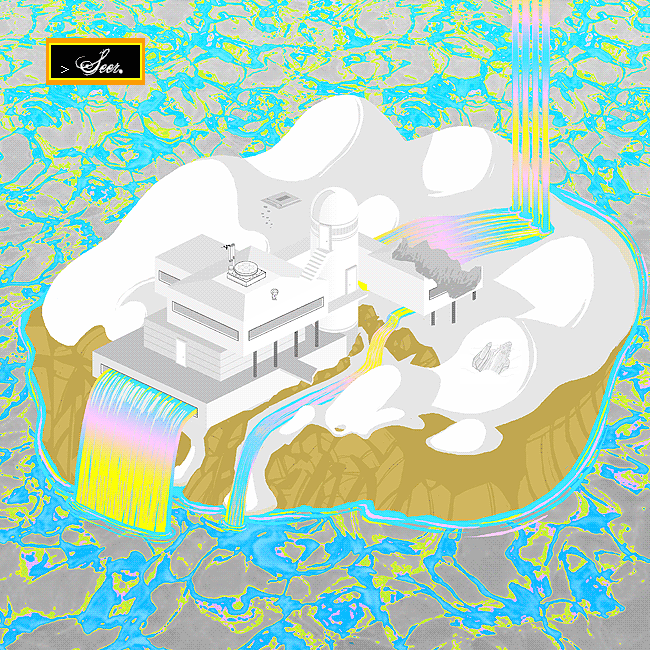
O’MALLEY: So now you’re making a real live Homestuck adventure game via Kickstarter. When did the idea for the game come up? Were you, like me, always wishing you could make an adventure game from the ages of ten to… never stopping?
HUSSIE: Yeah, I’ve always had the idea of making a game bouncing around my head. I feel like anyone who played a lot of games as a kid almost certainly wanted to make a game at some point, if not actually imagining it as their profession some day. I didn’t always want to make an adventure game. For a long time when I was a kid I wanted to make a killer role-playing game. Like Final Fantasy 3… TWO!!! Something exactly like that. The idea for the big “game-making fantasy” that is undoubtedly common among so many of us changed a lot for me, like from platformer to RPG to adventure game, but I think the notion was always there. I thought about making a Problem Sleuth game when I was wrapping that story up. I probably would have, if I didn’t get so busy with Homestuck right away.
So it was pretty much a no-brainer to see this Kickstarter wave and pounce on that to actually bring to life this perma-fantasy of making a game. Since the idea to do it was always there, it was just a matter of actually obtaining the means, squaring up the time, and then actually going through a process that is undoubtedly 10 times more difficult and less glamorous than anyone who daydreams about game design ever realizes. But I think I’ve prepared myself for those rigors pretty adequately.
O’MALLEY: The Kickstarter campaign is about to close with over two million dollars. To me, this really vindicates the Homestuck fandom as a powerful entity in its own right. This makes Homestuck “real.” You’ve had no advertising, no corporate backing, just a real groundswell of love and weird grey kids on Tumblr — proof of the power word-of-mouth can have with something truly original and cool. So how excited are you right now?
HUSSIE: It’s an odd sensation of being extremely excited, felt in very small pockets of space between perpetual activity as I keep taking care of business. It’s hard to slow down to really experience all that this represents because there’s still so much to do. On a pure “holy s***” level, there’s a lot to be said for it. Let’s face it, in normal person world, which at least I think is where I still live, a million bucks is a lot of f***ing money. Like, remember how that was always the ultimate prize in game shows and reality TV, as if it was the absolutely undisputed benchmark for a dauntingly inaccessible pile of wealth? The irreducible Pot of Gold. People would sit in a chair and answer, like, 50 really hard questions and fail every day on Who Wants To Be A Millionaire? Or in Survivor, you’d go to an island full of a**holes and eat bugs and almost die for like two months just for a shot at a million. But here all I did was put together a few nice looking prize packs and pushed a button and I blink and suddenly there’s two million there. These are silly and startling times we live in. It’s not merely an age of excitement. It’s an age where dollar figures apparently begin to lose their meaning, and the nature of quantitative reality itself starts to come apart at the seams.
But aside from being busy now, there are still a lot of forces to temper the excitement. The biggest elephant in the room for me is finishing Homestuck. It’s going to take a lot of focus to finish it, and getting too deep into game design sounds like the perfect way to derail that. So a lot of my enthusiasm for this game project will have to be deferred until next year. Another factor is the budget. While 2 million is crazy money, and gets regular people to do insane things on TV for it, it is by no means the dream budget when it comes to games. So this isn’t about me waving a magic wand and making anything that’s in my head appear on your computer, which frankly is the proposition that makes the average game enthusiast feel excited when they think about making a game. That budget is actually going to create a lot of tough creative choices. You always want the money you have to be maximized to make the best product, but the question is, how? If you get a little extra money in the budget, do you load it into nicer graphics? A richer gameplay experience? Coming to these conclusions is less about the excitement of creativity and more about making the practical judgments and compromises of a producer. That’ll be what we’re involved with soon after the Kickstarter ends, and the real excitement will come later, when I’m ready to begin the more purely creative work on it.

